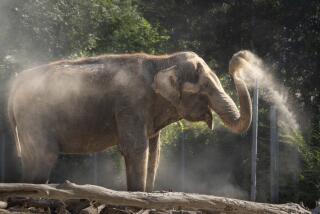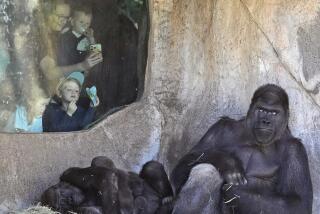National Zoo Investigating Deaths of 2 Young Zebras
WASHINGTON — Two young zebras of an endangered species died at National Zoo facilities this winter, apparently because keepers failed to feed them enough fat and protein and keep them sufficiently warm during Washington’s frigid nights, officials said Friday.
A 1-year-old male zebra from the Detroit Zoo spending his first winter in the nation’s capital, was discovered dead in a heated barn at the zoo Feb. 1 after a night when the temperature fell to 24 degrees.
The other zebra, an 8-year-old male with a history of medical problems, died Jan. 22 at the zoo’s Front Royal, Va., Conservation and Research Center.
National Zoo spokesman Robert Hoage said post-mortem exams indicate that both animals died of the cold weather and had all but depleted their energy stores of fat. Pathologists are looking at whether preexisting medical conditions might have made them more susceptible to the cold.
“The National Zoo is saddened by these losses and is determined to take whatever measures are necessary to prevent such deaths in the future,” Hoage said. “This is a serious situation.”
Both animals were Grevy’s zebras, a solitary, grazing species native to the arid, bushy grasslands of Eastern Africa. The striped creatures are listed as “threatened” on the endangered species list because poachers who sold their hides sharply reduced the population during the 1970s. Only about 5,400 remain in the wild, and about 220 are in North American zoos.
The zebras, named for Jules Grevy, a French president who was given the animals by the king of Ethiopia, live up to 18 years in the wilderness and as long as 30 years in captivity.
The National Zoo replaced its common zebras with Grevy’s zebras in 1993.
Hoage said the zoo’s three newest zebras had a special barn for winter shelter that was equipped with long electric heat panels that the animals could snuggle up against--and which were designed to keep the temperature inside at 50 degrees. But the temperature in the barn fell below 50, and one of the zebras died.
Hoage said it was unclear what went wrong at the barn in Front Royal, where the other zebra died.
Nutrition may have been another factor in the deaths. The zebras were on a diet of limited fat and protein to prevent them from becoming overweight and suffering leg problems. But zoo managers may have gone too far, Hoage said, because tests showed the dead zebras had almost no stored fat.
The zoo has since added space heaters to the zebra barn and installed foam padding covered with 6 inches of hay in the stalls. The two surviving zebras will be locked in the stalls when the temperature falls below freezing, Hoage said.
Zoo managers also have added protein and fat to the zebras’ meals, he said.
More to Read
Sign up for Essential California
The most important California stories and recommendations in your inbox every morning.
You may occasionally receive promotional content from the Los Angeles Times.










